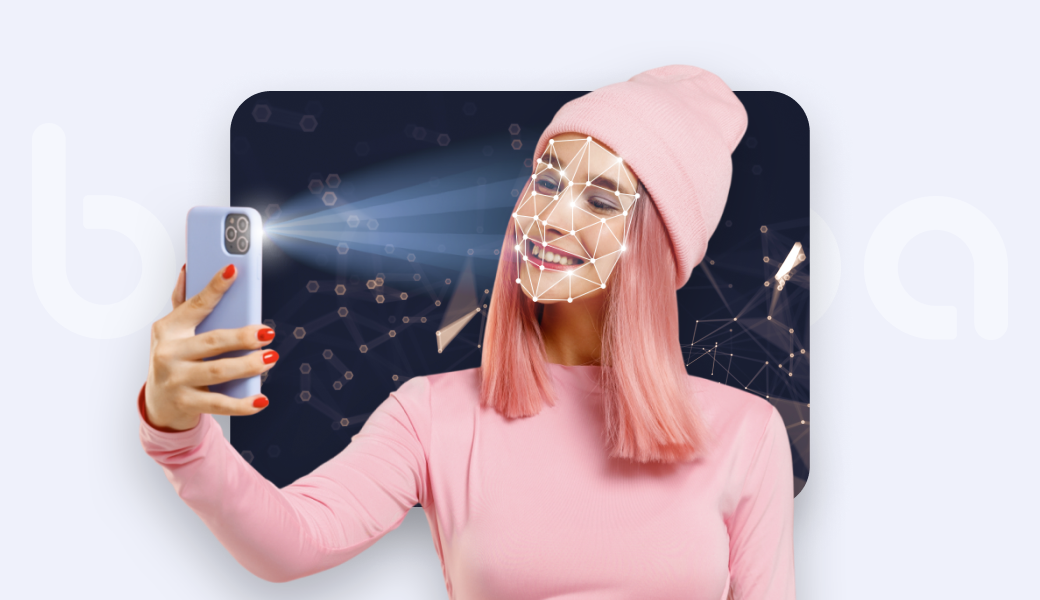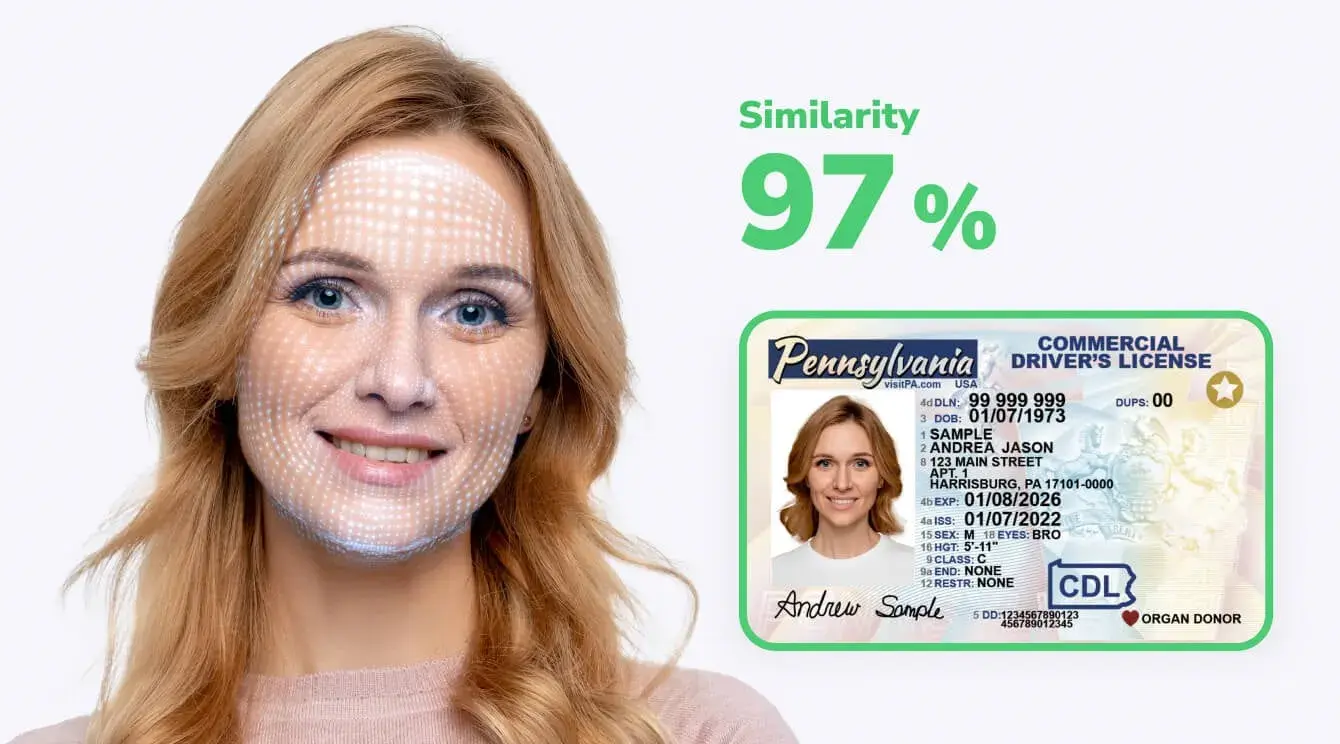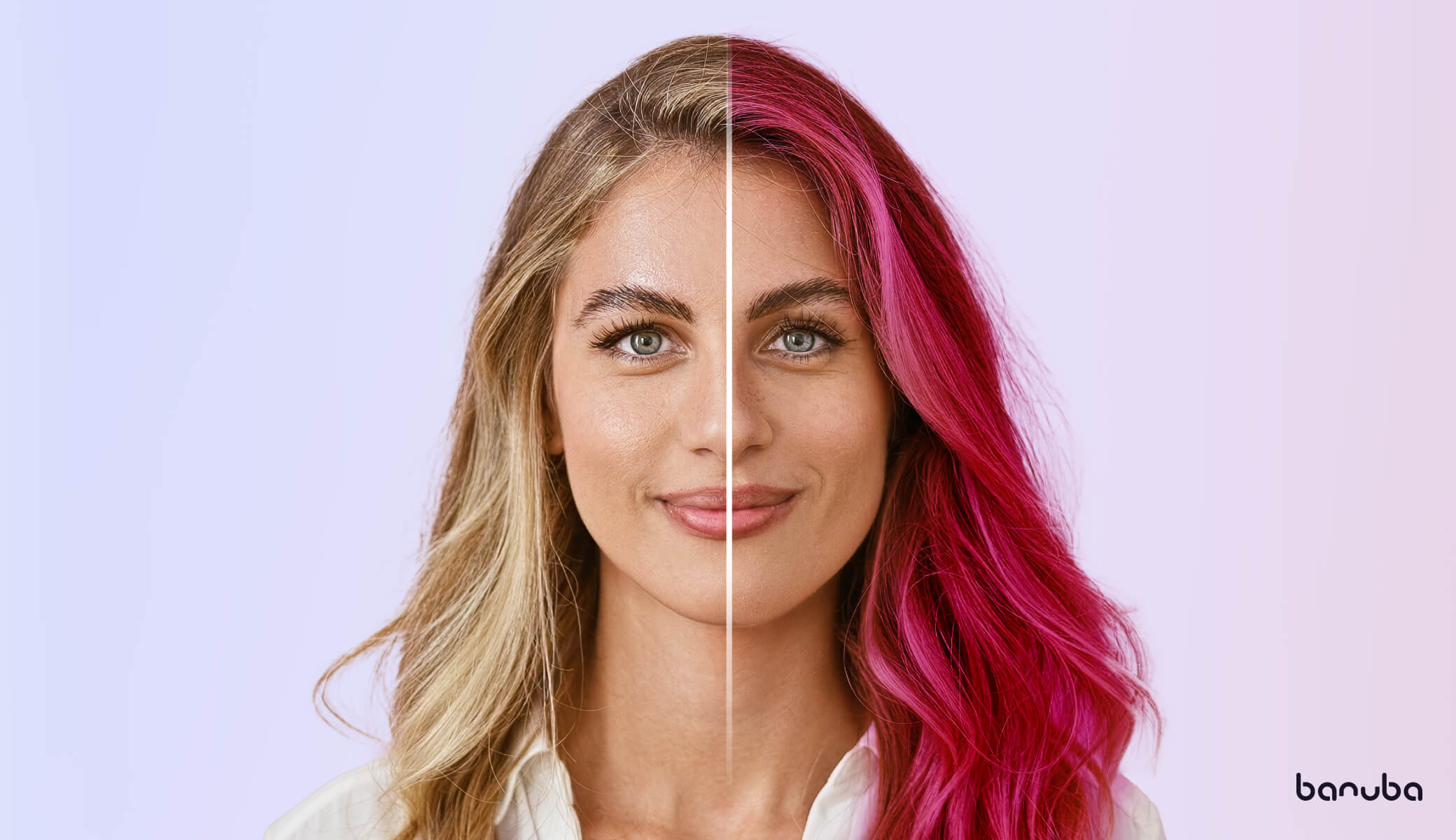[navigation]
TL;DR:
- The most important qualities when choosing a face recognition API are accuracy, feature set, platform compatibility, pricing, and scalability;
- Top face recognition SDKs/APIs include Banuba Face AR SDK, Microsoft Azure AI Vision, Amazon Rekognition, Face++, and Google Cloud Vision API.
Key Factors When Choosing a Face Recognition API in 2025
Choosing the best face recognition API for your project isn’t just about finding a tool to detect faces. It’s about balancing between accuracy, performance, versatility, and scalability. Here are the key aspects to consider in 2025:
Accuracy
The backbone of any face recognition web service is its accuracy. Look for APIs that demonstrate high performance in real-world public datasets like LFW, MegaFace, or custom in-house benchmarks.
Accuracy directly impacts everything from authentication success rates to precise overlaying in virtual try-on or marketing campaigns. Therefore, always ask for facial recognition examples and test them before implementing.
Features
Not all face recognition SDKs are created equal. Some go beyond basic detection and offer capabilities like:
- Age and gender estimation;
- Emotion analysis;
- Face comparison and matching;
- Liveness detection (to prevent spoofing);
- Facial landmark detection;
- Multi-face tracking in real time.
These features are especially valuable in use cases like retail analytics, virtual try-on, biometric access control, or customer behavior prediction.
Platform
The best face recognition library for your solution must be compatible with your tech stack. Are you looking for Android, web, iOS, or mobile face recognition SDKs or APIs? Whether you need a Python face recognition API for fast backend development or the face recognition API JavaScript integration for real-time browser experiences, your choice should align with your target platforms.
Some vendors, like Banuba, offer face recognition mobile SDKs with optimized neural networks that work across devices and operating systems with minimal latency.
Budget
Are you looking for a face recognition API free trial or enterprise-scale pricing? Review various pricing models and ensure they fit your budget:
- Free tiers or open-source options;
- Pay-as-you-go vs. subscription models;
- Cost per request, per face, or second of video;
- Licensing terms for commercial vs. research use.
We'll dive into face recognition API pricing later in the comparison. If you are tight on budget, consider using open-source face recognition libraries.
Scalability
Scalability becomes essential when your use case involves large datasets, video feeds, or millions of daily user interactions. Cloud-based APIs like Amazon Rekognition are excellent for horizontal scaling, while others offer edge-optimized SDKs for on-device processing.
If your project doesn’t require advanced features or enterprise-level support, a face recognition open-source solution may be a viable starting point for experimentation or academic use.
Banuba Face API – Best Overall for Accuracy and Features
Banuba’s Face API balances high-performance, accuracy, robust features, and ease of integration and stands out as one of the best face recognition models in 2025. With Gucci and Samsung among its customers, its solution is used for authentication, security, analytics, and marketing.
 Banuba's face mesh
Banuba's face mesh
Its AI-powered face tracking engine supports up to 69 facial landmarks, performs with exceptional accuracy in real-time, and works even in challenging conditions, such as poor lighting, partial face occlusion, and extreme angles.
Key Features:
- Face detection and multi-face tracking;
- Face recognition, verification, and comparison;
- Gender detection;
- Virtual try-on, AR effects, and triggers;
- Hand recognition and tracking;
- Emotion, tiredness, and heart rate tracking;
- Operates even with 70% facial occlusion;
- Liveness detection;
- Cross-platform support (Web, Windows, Mac, Android, iOS, Flutter, React Native, and Unity);
- Lightweight neural networks for on-device processing.
The number of users doesn't affect the price, making it highly scalable for potential business growth. You can explore this face recognition software SDK for free during a 14-day trial period, check out the Banuba’s Face API demo and review the sample code.

Amazon Rekognition – Best for Scalability
Amazon Rekognition is a cloud-based face recognition API developed by AWS that excels in large-scale image and video analysis. Known for its seamless integration with the broader AWS ecosystem, it’s a go-to solution for enterprises needing scalable facial recognition across multiple platforms and services.
 Source
Source
It supports real-time video stream processing, facial detection and comparison, and facial attribute analysis (like emotions or age range). While it's enterprise-ready, its pricing structure may become costly for high-volume video tasks.
Key Features:
- Face detection and tracking in images and videos;
- Face recognition and facial comparison;
- Age range, gender, and emotion analysis;
- Text and labels recognition;
- Celebrity recognition and unsafe content detection;
- Real-time video analysis with Kinesis Video Streams;
- Seamless AWS integration (S3, Lambda, SageMaker, etc.);
- Built-in support for scaling horizontally with high availability.
Rekognition is the best face recognition library for scalable enterprise-level applications in security, crowd analytics, law enforcement, and identity verification. However, the service is deeply tied to AWS infrastructure, which may be limiting for non-AWS-based projects. You can explore the sample code to dive in.
Pricing is usage-based: around $0.001 per image (first 1M) and $0.10 per minute for video analysis, with volume discounts available. There is no permanent free tier for facial recognition.
Microsoft Azure Face API – Best for Enterprise Integration
Microsoft Azure Face API is part of Azure’s Cognitive Services suite and is tailored for enterprises prioritizing data security, compliance, and seamless integration with Microsoft’s ecosystem. It’s widely used in sectors like banking, government, and healthcare, where identity verification and access control must meet strict standards.
This face recognition API offers robust face detection, recognition, and verification tools, supporting facial attributes like age, emotion, and head pose. Integration with services like Azure Active Directory, Power BI, and Dynamics 365 makes it ideal for building intelligent workflows. You can check the sample code here.
Key features:
- Face detection and facial landmarks;
- Face recognition and identity verification;
- Emotion, age, head pose, and facial hair analysis;
- Large-scale person group creation and face matching;
- Multi-face detection in a single image;
- Integration with Azure ecosystem (AD, Logic Apps, Cognitive Search);
- Enterprise-grade security and compliance (GDPR, ISO/IEC certifications).
While Azure Face API is excellent for large organizations, it has a complex pricing structure and requires a more profound familiarity with Azure services to fully unlock its potential.
Pricing starts from $1.50 per 1,000 transactions (face detection), with separate tiers for verification and group identification. A free tier offers up to 30,000 monthly transactions for face detection and 1,000 for recognition.
Google Cloud Vision API – Best for Image Analysis
Google Cloud Vision API is a comprehensive image recognition platform with facial detection among various capabilities. While it's not a specialized face recognition API like others in this list, it's a solid option for projects where facial analysis is just one part of a larger image-processing workflow.
 Source
Source
It supports label detection, optical character recognition (OCR), object detection, and facial landmarks. This makes it particularly valuable for applications focused on content moderation, media intelligence, and image cataloging at scale.
Key features:
- Face detection and landmark localization;
- Emotion detection (joy, sorrow, anger, surprise);
- Image label detection and classification;
- OCR (text detection in images);
- Object and logo detection;
- Content moderation (explicit content filtering);
- Integration with Google Cloud Storage and AutoML.
Google Vision is an excellent fit for teams already invested in the Google Cloud ecosystem. However, its facial recognition capabilities are limited to detection and expression analysis. It doesn’t support identity verification or face matching.
Pricing is based on request volume. Face detection costs $1.50 per 1,000 units, with a free tier of 1,000 units per month. You can explore the sample code here.
Face++
 Source
Source
Face++ by Megvii is a feature-rich face recognition API that caters to developers seeking highly customizable and flexible face-related capabilities. It’s particularly popular in Asia and used in projects that require a broad suite of biometric tools, including gesture recognition and body analysis.
While not as globally dominant as AWS or Azure, Face++ offers a wide array of specialized modules and a developer-friendly platform. However, its performance may vary by region, and some features are better suited to experimental or niche applications than production-grade systems.
Key features:
- Face detection, recognition, and verification;
- Facial attributes analysis (age, gender, emotion);
- Face comparison and searching within datasets;
- Liveness detection and anti-spoofing;
- Gesture recognition and body analysis tools;
- Extensive documentation and online testing console with sample code;
- SDKs available for web, Android, and iOS platforms.
Face++ supports common use cases such as smart retail, public safety, and fintech authentication, especially in regions where local hosting and data handling are critical. This face recognition also offers RESTful APIs with quick setup for prototyping.
Pricing varies based on API type, usage volume, and region, and is typically structured around monthly API calls. Free access is available for low-volume or testing purposes.
Comparison Table: Face Recognition API Features at a Glance

Conclusion
The best face recognition API match for your business depends on your goals, from scaling security systems, building mobile apps, to enhancing user experiences with real-time analytics and virtual try-ons.
- Banuba Face API stands out for its accuracy, feature depth, and cross-platform support, which make it ideal for authentication, AR, and customer analytics;
- Amazon Rekognition is best for scalable, cloud-based deployments;
- Microsoft Azure Face API suits enterprises needing tight integration and compliance;
- Google Cloud Vision offers broad image analysis with facial detection;
- Face++ caters to niche projects with advanced biometric tools.
If you're looking for the most balanced option in 2025, Banuba’s Face API delivers on performance, versatility, and business-ready scalability, making it our top recommendation.

References
Banuba. (n.d.). Face API. Banuba. https://www.banuba.com/face-api
Banuba. (n.d.). Face Recognition SDK. Banuba. https://www.banuba.com/face-recognition-sdk
Banuba. (n.d.). Face AR SDK Documentation. Banuba. https://docs.banuba.com/far-sdk/
Eden AI. (2024). Best Face Recognition APIs. https://www.edenai.co/post/best-face-recognition-apis
Face++. (n.d.). Face Detection. https://www.faceplusplus.com/face-detection/
Face++. (n.d.). Face++ Homepage. https://www.faceplusplus.com/
Google Cloud. (n.d.). Cloud Vision API. Google. https://cloud.google.com/vision
Google Cloud. (n.d.). Face Detection Sample – Vision API. Google. https://cloud.google.com/vision/docs/samples/vision-face-detection?hl=en
Google Cloud Console. (n.d.). Cloud Vision API Library. Google. https://console.cloud.google.com/apis/library/vision.googleapis.com
Lets AI. (2024). Evaluating the Accuracy and Effectiveness of Azure Face API in Face Detection and Recognition. https://www.letsai.tech/post/evaluating-the-accuracy-and-effectiveness-of-azure-face-api-in-face-detection-and-recognition
Luxand. (2023). Azure Face API: Strengths, Limitations, and Use Cases. Medium. https://medium.com/@luxand/azure-face-api-c3bb5edfa22b
Microsoft. (n.d.). Characteristics and Limitations of the Face API. https://learn.microsoft.com/en-us/legal/cognitive-services/face/characteristics-and-limitations
Microsoft. (n.d.). Computer Vision Overview – Identity Services. https://learn.microsoft.com/en-us/azure/ai-services/computer-vision/overview-identity
Microsoft. (n.d.). Quickstart: Use the Azure Face Client Library. https://learn.microsoft.com/en-us/azure/ai-services/computer-vision/quickstarts-sdk/identity-client-library?tabs=windows%2Cvisual-studio&pivots=programming-language-csharp
Microsoft Azure. (n.d.). Face API Pricing. https://azure.microsoft.com/en-us/pricing/details/cognitive-services/face-api/
Statista. (2024). Facial Recognition – Worldwide. https://www.statista.com/outlook/tmo/artificial-intelligence/computer-vision/facial-recognition/worldwide
Amazon Web Services. (n.d.). Amazon Rekognition. https://aws.amazon.com/rekognition/
Amazon Web Services. (n.d.). DetectFaces API Reference – Amazon Rekognition. https://docs.aws.amazon.com/rekognition/latest/dg/example_rekognition_DetectFaces_section.html









